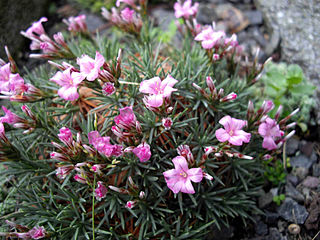
A forb or phorb is a herbaceous flowering plant that is not a graminoid. The term is used in biology and in vegetation ecology, especially in relation to grasslands and understory. Typically these are dicots without woody stems.

Plumbaginaceae is a family of flowering plants, with a cosmopolitan distribution. The family is sometimes referred to as the leadwort family or the plumbago family.

Acantholimon is a genus of small flowering plants within the plumbago or leadwort family, Plumbaginaceae. They are distributed from southeastern Europe to central Asia and also in South America, but also cultivated elsewhere in rock gardens.

Pierre Edmond Boissier was a Swiss prominent botanist, explorer and mathematician. He was the son of Jacques Boissier (1784-1857) and Caroline Butini (1786-1836), daughter of Pierre Butini (1759-1838) a well-known physician and naturalist from Geneva. With his sister, Valérie Boissier (1813-1894), he received a strict education with lessons delivered in Italian and Latin. Edmond's interest in natural history stemmed from holidays in the company of his mother and his grandfather, Pierre Butini at Valeyres-sous-Rances. His hikes in the Jura and the Alps laid the foundation of his zest for later exploration and adventure. He attended a course at the Academy of Geneva given by Augustin Pyramus de Candolle.
Acantholimon koeycegizicum, is a species of plant belonging to the family Plumbaginaceae.
Acantholimon goeksunicum is a species of plant belonging to the family Plumbaginaceae. It is only found on calcareous steppes in southeastern Anatolia (Turkey).

Caryophyllales is a diverse and heterogeneous order of flowering plants that includes the cacti, carnations, amaranths, ice plants, beets, and many carnivorous plants. Many members are succulent, having fleshy stems or leaves. The betalain pigments are unique in plants of this order and occur in all its families with the exception of Caryophyllaceae and Molluginaceae.

Aegialitis is a genus of two shrubby mangrove species, with one native to Southeast Asia and the other native to Australia and Papua New Guinea.
Acantholimon karamanicum is a species of flowering plant. It grows on calcareous mountain slopes in Ermenek.

Acantholimon libanoticum(Lebanese prickly thrift, غملول لبناني) is a plant in the family Plumbaginaceae first described by Pierre Edmond Boissier. It is native to Western Asia from Turkey to Syria and Lebanon.
Igor Alexandrovitch Lintchevski was a Russian botanist.

Goniolimon tataricum is a species of flowering plant in the genus Goniolimon, family Plumbaginaceae. It is called German statice, Tatarian sea-lavender, Tartarian statice or just statice. It is native to Albania, Algeria, Bulgaria, Greece, Kazakhstan, the North Caucasus, Romania, Southern Russia, Tunisia, Ukraine and the former Yugoslavia. It is planted in gardens as a border and ground cover, and also used in the cut flower industry.
Alexander Gilli was an Austrian botanist and pteridologist. He was a pioneer in research on plant communities.
Acantholimon gillii is a species of plant described by Karl Heinz Rechinger and Mogens Engell Köie. Acantholimon gillii is part of the genus Acantholimon and the family Plumbaginaceae. No subspecies are listed in the Catalog of Life.
Acantholimon ekatherinae is a species of Plumbaginaceae in the genus Acantholimon. It native to Kazakhstan and Uzbekistan in central Asia.

Acantholimon acerosum is a species of plant in the Plumbaginaceae family that is native from Turkey to Northwest Iran. The species are evergreen and sprout flowers June. Acantholimon acerosum grows in light well drained soil that are gritty and limey.
Acantholimon acanthobryum is a species of flowering plant in the Plumbaginaceae family. The species is epidemic to Ghazni, Afghanistan and was discovered by Rech.f. & Schiman-Czeika.

Acantholimon ulicinum, also known as the prickly thief, is a species of broadleaf evergreen plants in the family Plumbaginaceae. Acantholimon ulicinum is around 10 cm (4 in) tall and has a spread of 30 cm (1 ft). The species is endemic to the eastern Mediterranean region where it grows in dry soil. From June to July is when Acantholimon ulicinum blooms, with pale pink flowers. It has crowded, rigid, hard-textured, spiny-tipped, linear and needle-like leaves, and five-petaled pink flowers in short-stalked inflorescences.
Acantholimon trojanum, also known as prickly thrift, is a species of perennial plant. It is native to Turkey and can survive in hardiness zones 5a to 9b. The species typically reaches a height of around 1.2 meters (4 ft). Acantholimon trojanum grows in rocky soil and has a foliage colour of green and blue with flowers being pink, and blooms in the summer. The leaves are food items for deer and rabbit species.
This page is based on this
Wikipedia article Text is available under the
CC BY-SA 4.0 license; additional terms may apply.
Images, videos and audio are available under their respective licenses.









